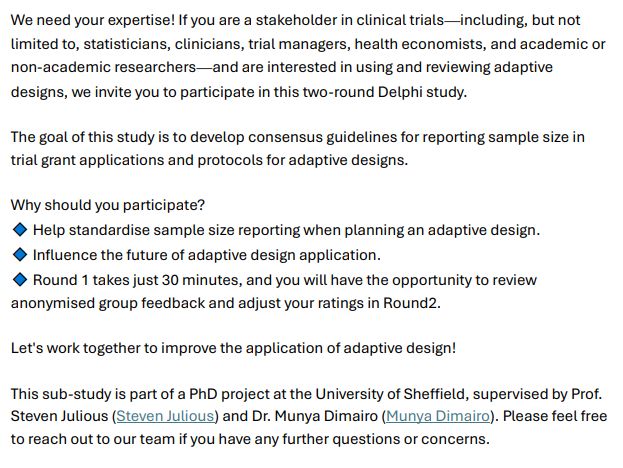How is missing data handled in cluster randomized controlled trials? A review of trials published in the NIHR Journals Library 1997–2024
journals.sagepub.com/doi/10.1177/...
06.10.2025 11:14 — 👍 0 🔁 1 💬 0 📌 0
Bookings are open for our online short course How to Understand Statistics in Research
Thursday 1st May - Thursday 22nd May 2025 (4 half-day sessions, over 4 consecutive weeks)
Course lead:
@richardjacques.bsky.social
For more information see:
www.sheffield.ac.uk/smph/modules...
02.04.2025 08:35 — 👍 0 🔁 0 💬 0 📌 0
The 'Reducing Avoidable Admissions in Acute Hospital Care: The role and impact of Same Day Emergency Care Services' project website is now live.
Find out about our research at: sites.google.com/sheffield.ac...
@sheffielduni.bsky.social @fohsheffield.bsky.social @arc-yharc.bsky.social
02.04.2025 06:47 — 👍 2 🔁 1 💬 1 📌 0

Invitation to a Two-Round Delphi Study on Sample Size Reporting in Trial Grant Applications and Protocols for Adaptive Designs!
Click the link below to participate 👏:
docs.google.com/forms/d/e/1F...
Or directly contact: qzhang104@sheffield.ac.uk.
17.02.2025 13:55 — 👍 1 🔁 5 💬 1 📌 1
Please add me 🙂
16.02.2025 20:09 — 👍 3 🔁 0 💬 0 📌 0
In Nov I started my first NIHR funded research project as Chief Investigator.
Over the next 30 months, I'll be working with a fantastic team to investigate the impact of Same Day Emergency Care (SDEC) services on acute hospital admissions and discharge.
fundingawards.nihr.ac.uk/award/NIHR16...
04.02.2025 16:01 — 👍 2 🔁 1 💬 0 📌 0
How to Understand Statistics in Research
Day 1: Thursday 1st May 2025 Day 2: Thursday 8th May 2025 Day 3: Thursday 15th May 2025 Day 4: Thursday 22nd May 2025 All sessions run from 9am - 1pm (BST)
Bookings are open for our online short course How to Understand Statistics in Research
Thursday 1st May - Thursday 22nd May 2025 (4 half-day sessions, over 4 consecutive weeks)
Course lead: @richardjacques.bsky.social
For more information see:
www.sheffield.ac.uk/smph/modules...
30.01.2025 18:30 — 👍 0 🔁 1 💬 0 📌 0
Cost-effectiveness of an extended-role general practitioner clinic for persistent physical symptoms: results from the Multiple Symptoms Study 3 (MSS3) pragmatic randomised controlled trial
www.valueinhealthjournal.com/article/S109...
02.11.2024 09:21 — 👍 1 🔁 0 💬 0 📌 0
New paper published in Statistical Methods in Medical Research:
Comparison of statistical methods for the analysis of patient-reported outcomes in randomised controlled trials: A simulation study
journals.sagepub.com/doi/10.1177/...
23.10.2024 09:20 — 👍 1 🔁 2 💬 1 📌 0
Working to reduce the burden of ill health through our world class primary care research and teaching. Established in 1997.
https://www.phpc.cam.ac.uk/research/departmental-research-units/primary-care-unit
Co-Creating Ireland's Public Involvement in Open Research Roadmap
ENGAGED is building a national roadmap to shape public involvement in open research in Ireland. We believe that research can and does play an important role in tackling societal challenges.
(Resident) Doctor 🩺 ST3 Emergency Medicine Trainee 🚑 NIHR Academic Clinical Fellow 📚 Occasional medic for SportsMedics LTD ⚕️All views my own 🐝
Oncology trials and biostatistics https://scholar.google.co.uk/citations?user=ZbSK3WwAAAAJ
We are a group of researchers at the University of Sheffield working to improve skin health of adults and children.
Research Fellow in Statistics and Deputy Director of Statistics | Centre for Trials Research, Cardiff University | Patient Reported Outcome Measures | Psychometrics | Rasch measurement theory | Rheumatoid Arthritis Disease Activity
The University of Sheffield Player - the UK’s biggest research streaming platform enabling anyone, anywhere to discover and explore our pioneering research.
🌐 https://bit.ly/4fyGi93
All about Statistical Methods in Clinical Trials and Good Statistical Practice in Healthcare Research at Imperial Clinical Trials Unit (ICTU), Imperial College London #StatsCI
www.statsci.co.uk
LHGP aim to identify, implement and evaluate the population-level actions most likely to improve health, wellbeing and equity at scale. It will also work specifically to explore and address the barriers to implementing these actions.
A network of academic clinical trials units who have been assessed by an international panel of experts. Reposting does not mean endorsement.
Senior Publisher of #Mathematics, #Statistics, #DataScience, and #Physics books at Chapman & Hall/CRC, part of the Taylor & Francis Group. @tandfresearch.bsky.social #RStats
Prof MSK Health and Care at Health Sciences University, Editor Int Jn Osteo Med, President Society Back Pain Research.
I am an evidence synthesis methodologist and epidemiologist. I explore bias in Network Meta-Analysis and automation of bias assessment in systematic reviews. I work in Squamish, BC, and am an avid rock climber and gardener. #NMA #metaresearch
Sustainability research centre at The University of Sheffield
https://sheffield.ac.uk/grantham-centre
Bringing together data science expertise across LSHTM to tackle the biggest global health problems.
Official feed of the UK Health Security Agency (UKHSA) providing regular news updates on the work of the organisation.
Our mission is to tackle inequality in healthcare by bringing together researchers, clinicians, patients and industry to co-create equitable digital innovations. Funded by EPSRC and UKRI.
Formerly @SoYoDHH on X / Twitter
The NIHR ARC East Midlands is one of 15 ARCs (@nihrarcs.bsky.social) supporting applied health and care research, funded by the National Institute for Health and Care Research (@nihr.bsky.social).















